1910-1919
1919 Cadillac
- Details
- Written by Big Block
- Category: 1910-1919
- Hits: 2050
1919 Cadillac
Type 57
TYPE 57 was similar to the 1918 Type 57 except:
Bodies
- Twenty-five vertical hood louvers.
- The Phaeton was 1.5" (38 mm) lower.
- There was no Victoria convertible.
- Instead it replaced the leather roof and rear quarter with aluminum.
- The Brougham was replaced by a sedan with full width front seat and no emergency seats.
- The Town Limousine was renamed Town Brougham.
- The Landaulet, Town Landaulet, and Hearse were dropped.
- Because Fisher made minor changes in details on the Victoria, Suburban, and Sedan, the bodies were identified as 57-A and 57-B.
- This was a body designation only, not a Type designation.
- There was no Type 57-B Cadillac. The 57-B bodies had a square effect at the corners of the body, door and window. The lower edge of the windshields followed the curve of the cowl.
Chassis: No significant change from 1918
Drive Line: No significant changes from 1918.
Engine: No significant changes from 1918.
I. D. DATA |
Serial numbers were not used. Engine numbers were stamped on the crankcase just back of the right hand bank of cylinders, and on a plate on the dash. They were also stamped on the fan shaft housing. Engine No.: 57-A-1 through 57-Z-1000 with 1918, and 57-AA-1 through 57-TT-146
| Style No. | Doors | Type | Seating | Price | Weight |
NA | 4 | Touring | 7 | 3220 | 4035 |
NA | 4 | Phaeton | 4 | 3220 | 3925 |
NA | 2 | Roadster | 2/4 | 3220 | 3865 |
3040 | 2 | Victoria | 4 | 3990 | 3970 |
3050 | 4 | Sedan | 5 | 4215 | - |
3260 | - | Imperial Sedan | - | - | - |
3210 | 4 | Limousine | 7 | 4520 | 4425 |
NA | 4 | Imperial | 7 | 4620 | - |
NA | 4 | Town Brougham | 6 | 4520 | 4295 |
2830 | - | Limousine | 8 | - | - |
3140 | 4 | Suburban | 7 | 4465 | 4350 |
3140-P1200 | - | Imperial Suburban | - | - | - |
NA | - | Police Patrol | - | 4050 | - |
NA | - | Ambulance | - | 4550 | - |
Note: Some overlap existed on new or deleted body styles for 1918 and 1919.
ENGINE |
| Description | Ninety degree V-8 L-head. Heads detachable. Cast iron blocks of four on Aluminum crankcase. |
| Bore & Stroke | 3-1/8 x 5-1/8 in. (79.4 x 130.2 mm) |
| Displacement | 314.5 cu. in. (6.4 liters) |
| Horsepower | S.A.E./N.A.C.C. 31.25 HP |
| Main bearings | Three |
| Valve Lifters | Rockers with roller cam follower acting on mechanical lifters |
| Carburetor | float feed, auxillary air control; manufactured by Cadillac under C. F. Johnson patents |
CHASSIS |
Type | Type 57 | Type 57 Roadster | Type 57 Limousine, Suburban | Special Chassis |
Wheelbase | 125 in. | 125 in. | 132 in | 145 in |
Tread (front/rear) | 56 in. | 56 in. | 56 in | - |
Tires | 35 x 5 | 34 x 4-1/2 | 35 x 5 | - |
TECHNICAL |
Transmission | Selective sliding gear transmission. Case in unit with engine |
Speeds | 3 Forward and 1 reverse |
Steering location | Left drive |
Control position | Center control (rhd opt) |
Clutch | Multiple disc, dry plate clutch, 17 discs |
Drive | Shaft drive |
Rear Axle | Spiral bevel, full floating rear axle |
Overall ratio | 4.44:1 |
Brakes | Mech. brakes on two wheels, one external, one internal |
Wheels | Wood artillery wheels, demountable rims (Rudge-Whitworth wire wheels opt) |
Wheel size | 25 in |
Optional Drive ratio | 3.94:1, 5.07:1 |
OPTIONS |
Front bumper | $12.50 |
Rear bumper | $12.50 |
Cigar lighter | $5.00 |
Seat covers | $13.50-125.00 |
Spotlight | $7.50 |
Set of five Rudge-Whitworth wire wheels | $150.00 |
Tire chains | $9.00 |
Rear view mirror | $3.75 |
HISTORICAL |
- The 1919 Type 57 was a continuation of 1918 Type 57.
- Model year sales: 45,146 with 1918.
- Model year production: 45,146 with 1918.
- The president and general Manager was Richard H. Collins.
1918 Cadillac
- Details
- Written by Big Block
- Category: 1910-1919
- Hits: 2251
1918 Cadillac
Type 57
TYPE 57 was similar to Type 55 except:
Bodies
- Top line of hood and cowl now a continuous straight line to the windshield on most body styles.
- Headlight reflectors tilted by mechanical linkage to lever on steering post.
- Nine hood louvers tilted six degrees.
- Windshield on all open cars tilted six degrees.
- Club Roadster, Coupe, Convertible Touring, and Touring Couplet dropped from the line.
- Town Limousine and Town Landaulet added.
- The main compartment of these two bodies was approximately four inches narrower than on the standard Limousine.
- Suburban added in mid-year.
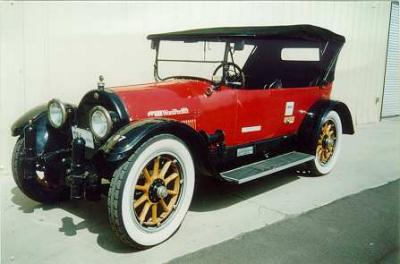
Chassis: No significant change from Type 55.
Drive Line: Transmission redesigned and is not interchangeable with Types 51, 53, 55.
Engine
- Detachable cylinder heads.
- "Belted" pistons replaced by ultra light weight pistons.
I. D. DATA |
Serial numbers were not used. Engine numbers were stamped on the crankcase just back of the right hand bank of cylinders, and on a plate on the dash. Also stamped on the fan shaft housing. Engine No.: 57-A-1 through 57-Z-1000 with 1919.
Style No. | Doors | Type Name | Seating | Price | Weight |
NA | 4 | Touring | 7 | 2590 | 4035 |
NA | 4 | Phaeton | 4 | 2590 | 3925 |
NA | 2 | Roadster | 2/4 | 2590 | 3865 |
2750 | 2 | Convertible Victoria | 4 | 3075 | 3970 |
2730 | 4 | Brougham | 5/7 | 3535 | 4290 |
NA | 4 | Brougham | 7 | 4125 | - |
2740 | 4 | Limousine | 7 | 4085 | 4425 |
2820 | - | Limousine | - | - | - |
2680 | 4 | Town Limousine | 6 | 4100 | 4295 |
3110 | - | U.S. Government Limousine | - | - | - |
2760 | 4 | Imperial | 7 | 4285 | - |
2770 | 4 | Landaulet | 7 | 4235 | 4510 |
2840 | 4 | Town Landaulet | 6 | 4250 | 4350 |
2910 | 4 | Suburban | 7 | 4090 | 4350 |
NA | - | Police Patrol | - | 3850 | - |
NA | - | Ambulance | - | 4350 | - |
NA | - | Hearse | - | 4685 | - |
Note: Prices increased several times during the war years, partly due to war taxes. The lowest prices for the body style are given.
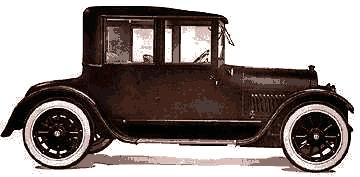
| Description | Ninety degree V-8 L-head. Heads detachable. Cast iron blocks of four on Aluminum crankcase |
| Bore & Stroke | 3-1/8 x 5-1/8 in. |
| Displacement | 314.5 cu. in. |
| S.A.E./N.A.C.C. Horsepower | 31.25 |
| Main bearings | Three |
| Valve lifters | Rockers with roller cam follower acting on mechanical lifters |
| Carburetor | float feed with auxil iary air control; manufactured by Cadillac under C. F. Johnson patents |
CHASSIS |
| - | Type 57 | Type 57 Roadster | Type 57 Limo, Land, Imp, Town Limo, Town Land | Special Chassis |
| Wheelbase | 125 in. | 125 in. | 132 in. | 145 in. |
| Front/Rear Tread | 56 in. | |||
| Tires | 35 x 5 | 34 x 4-1/2 | 35 x 5 | |
TECHNICAL |
| Transmission | Selective, sliding gear transmission. Case in unit with engine |
| Speeds | 3 Forward and one Reverse |
| Steering position | Left drive, center control (Right hand drive optional) |
| Clutch | Multiple disc, dry plate, 17 discs |
| Drive | Shaft drive |
| Axle | Spiral bevel, full floating rear axle |
| Overall ratio | 4.44:1 |
| Brakes | Mechanical brakes on two wheels, one external, one internal |
| Wheels | Wood artillery wheels, demountable rims (R-W wire wheels optional) |
| Wheel size | 25 in. |
| Optional Final drive ratios | 3.94:1, 5.07:1 |
HISTORICAL |
- Introduced August, 1917.
- Model year sales: 45146 with 1919.
- Model year production: 45146 with 1919.
- The president and general manager was Richard H. Collins.
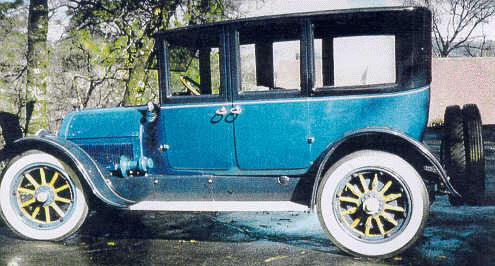
1917 Cadillac
- Details
- Written by Big Block
- Category: 1910-1919
- Hits: 3170
1917 Cadillac
Type 55
TYPE 55 is similar to Type 53 except:
Bodies
- New crown fenders and elimination of molding on hood panels and around doors give smoother appearance overall.
- Phaeton and Roadster have six degree slope to windshield.
- Salon replaced by Phaeton with bench seat in front.
- Club Roadster added.
- Convertible Touring (a four door hardtop) manufactured by Cadillac and having a Vee windshield is introduced.
- Coupe with cast Aluminum body is also manufactured by Cadillac.
- Victoria is now five window with fixed top and removable pillars.
- Berlin/Berline is now called Imperial (undoubtedly due to nasty connotation of "Berlin" at the time).
- Landaulet body style added.
- One listing of closed body styles by Fisher mentions "Touring Couplet," with no description.
- Previous round, plain door (rim) of headlights now embellished with stylized outline of shield and crown.
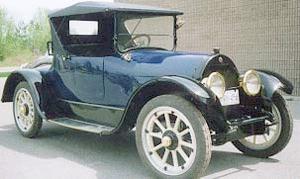
Chassis
- Frame depth increased to eight inches
- two tubular cross members added
- Wide tread no longer available.
Drive Line: Number of clutch plates increased to 17.
Engine
- Lighter pistons of "belted" design with large oil return holes in the piston walls.
- Exhaust manifolds have shorter connector pipes.
- Split, tapered collars used to retain valve spring feet.
I. D. DATA |
Serial numbers were not used. Engine numbers were stamped on the crankcase just back of the right hand bank of cylinders, and on a plate on the dash. Engine No.: 55-A-1 through 55-A-1000; 55-B-1 through 55-B-1000; etc., through 66-S-2.
| Model Number | Body | Series | Seating | Price |
NA | 4-dr. | Touring | 7 | $2250 |
NA | 4-dr. | Phaeton | 4 | $2240 |
NA | 2-dr. | Roadster | 2/4 | $2240 |
NA | 2-dr. | Club Roadster | 4 | $2240 |
NA | 2-dr. | Convertible Victoria | 4 | $2710 |
NA | 2-dr. | Coupe | 4 | $2960 |
NA | 4-dr. | Convertible Touring | 7 | $2835 |
2460 | 4-dr. | Brougham | 5/7 | $3110 |
2450 | 4-dr. | Limousine | 7 | $3760 |
2440 | 4-dr. | Imperial | 7 | $3910 |
2620 | 4-dr. | Landaulet | 7 | $3910 |
2470 | - | Touring Couplet | - | $- |
NA | - | Ambulance | - | $3760 |
NA | - | Police Patrol | - | $3160 |
NA | - | Hearse | - | $4040 |
Note: Prices $160 less previous to 14 December 1916.
Note: Touring Couplet may be same as Convertible Victoria.
ENGINE |
| Description | Ninety degree V-8 L-head. Heads not detachable. Cast iron blocks of four on Aluminum crankcase |
| Bore & Stroke | 3-1/8 x 5-1/8 in. |
| Displacement | 314.5 cu. in. |
| Compression ratio | 4.25:1 |
| S.A.E./N.A.C.C. Horsepower | 31.25 |
| Main bearings | Three |
| Valve lifters | Rockers with roller cam follower acting on mechanical lifters |
| Carburetor | float feed with auxiliary air control; manufactured by Cadillac under C. F. Johnson patents |
| Torque (Compression) | 180 lbs.-ft. @ 2000 R.P.M. |
CHASSIS |
| - | Type 55 | Type 55 Limo, Land, Imp | Special Chassis |
| Wheelbase | 125 in. | 132 in. | 145 in. |
| Front/Rear Tread | 56 in. | ||
| Tires | 36 x 4-1/2 | 37 x 5 | |
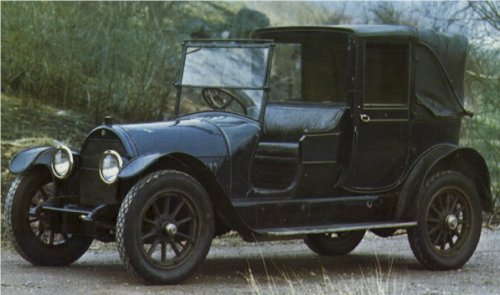
TECHNICAL |
| Transmission | Selective, sliding gear transmission. Case in unit with engine |
| Speeds | 3 Forward and one Reverse |
| Steering position | Left drive, center control (Right hand drive optional) |
| Clutch | Multiple disc, dry plate, 15 discs |
| Drive | Shaft drive |
| Axle | Spiral bevel, full floating rear axle |
| Overall ratio | 4.44:1 |
| Brakes | Mechanical brakes on two wheels, one external, one internal |
| Wheels | Wood artillery wheels, demountable rims (R-W or Houk wire wheels optional) |
| Wheel size | 27 in. |
| Optional Final drive ratios | 3.94:1, 5.07:1 |
HISTORICAL |
- Introduced August, 1916.
- Model year sales: 18,002.
- Model year production: 18,002.
- General Motors Corp. was incorporated Oct. 13, 1916 in Delaware.
- General Motors Co. was taken over by General Motors Corp. Aug. 1, 1917.
- General Motors Corp. was then an "operating" company and Cadillac Motor Car Co. became a Division of General Motors.
- Henry Leland left Cadillac in June, 1917 and Richard H. Collins became president and general manager.
1916 Cadillac
- Details
- Written by Big Block
- Category: 1910-1919
- Hits: 2747
1916 Cadillac
Type 53
Bodies:
Similar to Type 51 except:
- Hood line raised so that transition in cowl is less abrupt.
- Roof line of closed bodies raised again at front so that entire roof line is one gentle curve.
- Door shape changed.
- Five passenger Touring dropped.
- Salon now has four doors.
- Victoria body replaces Landaulet Coupe.
- Four passenger Coupe built by Cadillac added in mid-year.
- Five/seven (5/7p) Brougham replaces two door Sedan.
- The seating arrangement 7P denotes two folding auxiliary seats facing forward in the rear compartment. The seating arrangement 5/7P denotes two emergency "seats" in the rear compartment. These "seats" are rear-facing upholstered shelves hinged down out of the back of the front seat.)
- Touring body on special 132 inch chassis offered.
- Police Patrol, Ambulance, and Hearse bodies on special 145 inch chassis offered.
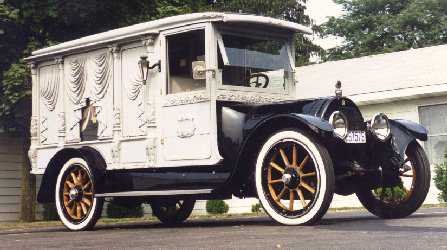
Chassis:
- Same as Type 51 plus 132 inch chassis also available.
Drive Line:
- Power tire pump moved from engine to transmission.
Engine:
- Power tire pump moved from engine to transmission.
- Distributor moved from rear to front of engine.
- Fan blades curved.
- Exhaust manifolds redesigned with curved connector pipes feeding into collector.
| I. D. DATA |
| Model Number | Body Type | Style | Seating | Price |
NA | 4-dr. | Touring | 7 | $2080 |
NA | 4-dr. | Salon | 5 | $2080 |
NA | 2-dr. | Roadster | 2/4 | $2080 |
1517 | 2-dr. | Victoria | 3 | $2400 |
NA | 2-dr. | Coupe | 4 | $2800 |
1518 | 4-dr. | Brougham | 5/7 | $2950 |
1744 | 4-dr. | Limousine | 7 | $3450 |
1519 | 4-dr. | Berline | 7 | $3600 |
NA | 4-dr. | 132 inch Touring | - | $- |
NA | - | Ambulance | - | $3455 |
NA | - | Police Patrol | - | $2955 |
NA | - | Hearse | - | $3880 |
| ENGINE |
| Description | Ninety degree V-8 L-head. Heads not detachable. Cast iron blocks of four on Aluminum crankcase |
| Bore & Stroke | 3-1/8 x 5-1/8 in. |
| Displacement | 314.5 cu. in. |
| Compression ratio | 4.25:1 |
| Brake Horsepower | 77 @ 2600 R.P.M. (60+ advertised) |
| S.A.E./N.A.C.C. Horsepower | 31.25 |
| Main bearings | Three |
| Valve lifters | Rockers with roller cam follower acting on mechanical lifters |
| Carburetor | float feed with auxiliary air control; manufactured by Cadillac under C. F. Johnson patents |
| Torque (Compression) | 180 lbs.-ft. @ 2000 R.P.M. |
| CHASSIS |
| - | Type 53 | Special Chassis |
| Wheelbase | 122 in. | 145 in. or 132 in. |
| Front/Rear Tread | 56 in. (61 opt) | |
| Tires | 36 x 4-1/2 | |
| TECHNICAL |
| Transmission | Selective, sliding gear transmission. Case in unit with engine |
| Speeds | 3 Forward and one Reverse |
| Steering position | Left drive, center control (Right hand drive optional) |
| Clutch | Multiple disc, dry plate, 15 discs |
| Drive | Shaft drive |
| Axle | Spiral bevel, full floating rear axle |
| Overall ratio | 4.44:1 |
| Brakes | Mechanical brakes on two wheels, one external, one internal |
| Wheels | Wood artillery wheels, demountable rims (R-W wire wheels optional) |
| Wheel size | 27 in. |
| Optional Final drive ratios | 3.94:1, 5.07:1 |
| OPTIONS |
| Seat covers | $35.00 - 65.00 |
| HISTORICAL |
- Introduced July, 1915.
- Model year sales: 18004.
- Model year production: 18004.
- The president and general manager was Henry Leland.
- In May, 1916, Erwin G. "Cannonball" Baker and Wm. F. Sturm drove a V-8 Cadillac Roadster from Los Angeles to New York City in 7 days, 11 hours, 52 minutes. They bettered their previous time, driven in another make of car, by 3 days, 19 hours, 23 minutes.
1915 Cadillac
- Details
- Written by Big Block
- Category: 1910-1919
- Hits: 2563
1915 Cadillac
Type 51
Bodies: Similar to 1914 bodies except:
- Side lights are smaller.
- Hood top panels blended smoothly into hood side panels.
- The shape of the doors changed.
- A three piece "Rain Vision" windshield was used on closed cars.
- The roof line of closed cars was raised at the front.
- The Cadillac "One-man" top with inside operating curtains which open with the doors was standard equipment.
- The top was fastened to the windshield, eliminating straps.
- The four passenger Phaeton was replaced by the two door Salon with passageway between individual front seats (right front seat revolves).
- The"Inside drive Limousine" of 1914 was now designated "Five Passenger Sedan."
- The Berline enclosed drive limousine was added.
- The designation "Imperial" used with "Sedan" (or "Brougham," "Suburban," etc.) denoted a regular Sedan with a glass partition added between front and rear compartments.
Chassis:
- First left drive Cadillac (right drive available as an option).
- Tread 56 inches (61 inch optional wide tread still available).
- Wheelbase 122 inches (145 inch chassis available without body).
- Wood wheels with ten spokes in front, twelve spokes in rear.
- Speedometer drive changed to right steering spindle.
- Rear springs three-quarter platform, front springs half-elliptic, six inches longer than in 1914.
- Ladder type frame changed to six inch deep "H" frame with three cross members.
Drive Line:
- Multiple disc, dry plate clutch with 15 steel plates, 7-3/4 in. dia. Alternate plates faced with wire mesh asbestos.
- Selective sliding gear transmission.
- Aluminum case in unit with engine.
- Tubular drive shaft with two universal joints.
- Torque arm.
- Spiral bevel drive in full floating rear axle.
Engine:
- Ninety degree L-Head V-8, 3-1/8 x 5-1/8, 314 cu. in.
- Cast iron cylinders in two blocks of four located exactly opposite on Aluminum-Copper alloy crankcase.
- Water jackets and combustion chambers integral.
- Water circulation and temperature control is by an impeller type pump with thermostat for each block of cylinders.
- Three 1-7/8 diameter bearings on crankshaft with four throws all in one plane.
- Fork and blade connecting rods.
- Rod bearings available standard, .005 under, and .020 under.
- Three rings, solid wall pistons and cylinder blocks available standard, first, and second oversize.
- Single camshaft with eight cams.
- Camshaft and generator shaft driven by silent chain.
- Motor/generator/distributor at rear, two cylinder power tire pump at front, inside engine Vee.
- Updraft carburetor, water-heated intake manifold, and log-type exhaust manifolds located inside Vee.
- Dual exhaust system with no balance pipe.
- Valves 1-9/16 diameter, 5/16 lift.
- Exhaust valves flat, intake valves tulip shape.
- Valves actuated by adjustable tappets which are activated by rocker arms with roller riding on cams.
- Firing order is: 1L-2R-3L-1R-4L-3R-2L-4R, where R(right) and L(left) are as viewed from the rear, and each bank is numbered one through four from the front.
- Valve chamber caps are stamped H, L, or LL for high or low compression ratios.
- Engine has three-point suspension.
- Ball and socket at front and solid at rear, forming an additional frame cross member.
- Before Engine No. A-7710, oil relief valve is cast integral with starter gear housing.
- Starting with Engine No. A-7710, oil relief valve is a separate unit mounted on angular face of crankcase.
- The lubrication system is recirculating, pressure fed from a gear type oil pump.
- The pump draws oil from the crankcase and forces it through a header pipe running inside the crankcase.
- Leads run from this pipe to the main bearings and then through drilled holes in the crankshaft to the connecting rod bearings.
- Pistons, cylinders, etc. are lubricated by oil thrown from the lower ends of the connecting rods.
- Oil from the rear end of the header pipe runs to the pressure relief valve.
- Overflow from this valve is gravity fed to the camshaft and chains, then drains back to the crankcase.
| I. D. DATA |
Serial numbers were not used. Engine numbers stamped on the crankcase just back of the right hand bank of cylinders, and on a plate on the dash. Starting: A-6000. Ending: A-19001.
| Model Number | Body | Style | Passengers | Price |
NA | 4-dr. | Touring | 7 | $1975 |
NA | 4-dr. | Touring | 5 | $1975 |
NA | 2-dr. | Salon | 5 | $1975 |
NA | 2-dr. | Roadster | 2/4 | $1975 |
602 | 2-dr. | Landaulet Coupe | 3 | $2500 |
601 | 4-dr. | Sedan | 5 | $2800 |
583 | 4-dr. | Limousine | 7 | $3450 |
NA | 4-dr. | Berline Limousine | 7 | $3600 |
715 | 4-dr. | Imperial Sedan | 5 | $- |
Note: Through 1919, Cadillac sometimes referred to Touring Cars and Roadsters as "Seven Passenger Car," "Five Passenger Car" or "Two Passenger Car." The designations "Touring" and "Roadster" are used herein for clarity.
| ENGINE |
| Description | Ninety degree V-8 L-head. Heads not detachable. Cast iron blocks of four on Aluminum crankcase |
| Bore & Stroke | 3-1/8 x 5-1/8 in. |
| Displacement | 314.5 cu. in. |
| Compression ratio | 4.25:1 |
| Brake Horsepower | 70 @ 2400 R.P.M. (60+ advertised) |
| S.A.E./N.A.C.C. Horsepower | 31.25 |
| Main bearings | Three |
| Valve lifters | Rockers with roller cam follower acting on mechanical lifters |
| Carburetor | float feed with auxiliary air control; manufactured by Cadillac under C. F. Johnson patents |
| Torque (Compression) | 180 lbs.-ft. @ 2000 R.P.M. |
| CHASSIS |
| - | Type 51 | Special Chassis |
| Wheelbase | 122 in. | 145 in. |
| Front/Rear Tread | 56 in. (61 opt) | |
| Tires | 36 x 4-1/2 | |
| TECHNICAL |
| Transmission | Selective, sliding gear transmission. Case in unit with engine |
| Speeds | 3 Forward and one Reverse |
| Steering position | Left drive, center control (Right hand drive optional) |
| Clutch | Multiple disc, dry plate, 15 discs |
| Drive | Shaft drive |
| Axle | Spiral bevel, full floating rear axle |
| Overall ratio | 4.44:1 |
| Brakes | Mechanical brakes on two wheels, one external, one internal |
| Wheels | Wood artillery wheels, demountable rims (wire wheels optional) |
| Wheel size | 27 in. |
| Optional Final drive ratios | 3.94:1, 5.07:1 |
| OPTIONS |
| Seat covers | $35.00 - 65.00 |
| Handy lamp | $2.00 |
| HISTORICAL |
- Introduced September, 1914.
- Innovations: High production V-8 engine.
- Model year sales: 13002.
- Model year production: 13002.
The president and general manager was Henry Leland.
1914 Cadillac
- Details
- Written by Big Block
- Category: 1910-1919
- Hits: 2536
1914 Cadillac
Same as 1913 except:
Bodies
- Torpedo body no longer available.
- Landaulet treatment on Coupe.
- Five passenger "Inside drive Limousine" (actually a center door sedan) is a new style.
- Hinged steering wheel and hinged driver's seat cushion facilitate entrance and exit for front seat passengers at right side of car.
- With smaller side lamps, bodies now have the appearance of enclosing the occupants and all the machinery.
Chassis
- Hinged steering wheel.
- Speedometer drive located in left steering knuckle.
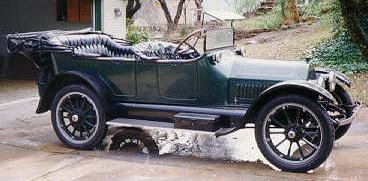
Drive line: Rear axle changed to Timken two-speed.
Engine
- Second ignition system for auxiliary use only.
- One distributor, one set of spark plugs.
- Fuel tank moved to rear of chassis.
- Hand pump on dash to pressurize tank for starting, camshaft driven pump for running.
- Power tire pump standard equipment.
I. D. DATA |
| Model Number | Body | Series | Passengers | Price |
NA | 4-dr. | Touring | 7 | $2075 |
NA | 4-dr. | Touring | 5 | $1975 |
NA | 4-dr. | Phaeton | 4 | $1975 |
NA | 2-dr. | Roadster | 2 | $1975 |
NA | 2-dr. | Landaulet Coupe | 3 | $2500 |
NA | 4-dr. | Standard Limousine | 7 | $3250 |
NA | 2-dr. | Inside Drive Limousine | 5 | $2800 |
ENGINE |
| Description | Vertical, in-line, L-head. Four cylinder. Individual cast iron cylinders, copper water jacket |
| Bore & Stroke | 4-1/2 x 5-3/4 in. |
| Displacement | 365.8 cu. in. |
| Brake Horsepower | 40-50 N.A.C.C. H.P.: 32.4 |
| Main bearings | Five |
| Valve lifters | Mechanical - push rod - roller cam followers |
| Carburetor | float feed; Made by Cadillac to C. F. Johnson patents |
CHASSIS |
| Wheelbase | 120 in. (Special Chassis 134 in.) |
| Front/Rear Tread | 56 in. (61 opt) |
| Tires | 36 x 4-1/2 |
TECHNICAL |
| Transmission | Selective, sliding gear transmission |
| Speeds | 3 Forward and one Reverse |
| Steering position | Right hand drive, controls to right |
| Clutch | Leather faced cone clutch |
| Drive | Shaft drive |
| Axle | Full floating rear axle |
| Differential | two-speed bevel drive, bevel gear differential |
| Overall ratio | 3.67:1 or 2.5:1 |
| Brakes | Mech. brakes on two wheels -- service / foot / contracting -- emerg./lever/expanding |
| Wheels | Wood artillery wheels, 10 & 12 spoke, demountable rims |
| Wheel size | 27 in. |
| Optional Final drive ratios | 4.07 or 2.50:1 |
OPTIONS |
| Seat covers | $32.50 - 65.00 |
| Handy lamp | $2.00 |
HISTORICAL |
- Introduced July, 1913.
- Innovations: Production two-speed rear axle.
- Model year sales: 14,003.
- Model year production: 14,003.
- The president and general manager was Henry Leland.
Note: The last four cylinder Cadillac for 67 years; and the final use by Cadillac of Alanson Brush design features.
Note: A 1914 Cadillac Touring (engine number 92,524) was awarded the 1913 Dewar Trophy as a result of electrical and two-speed-axle performance during a 1000-mile test conducted in September/October 1913.
Page 1 of 2